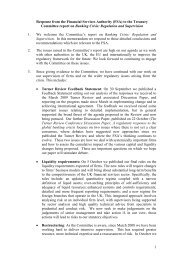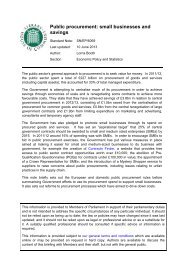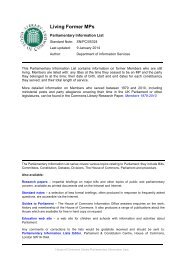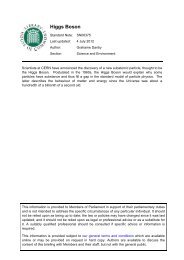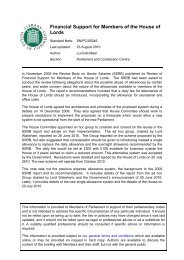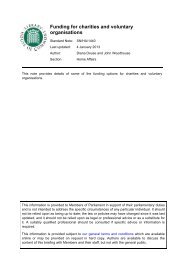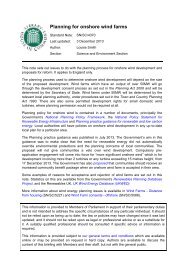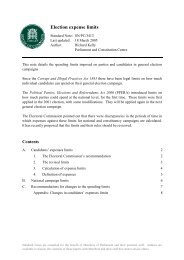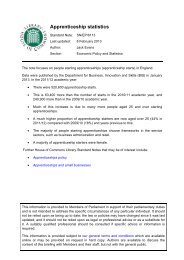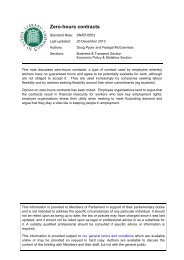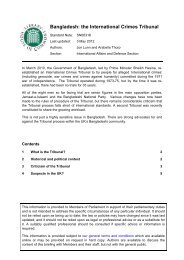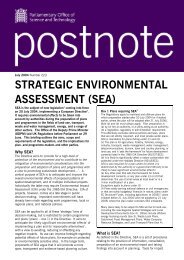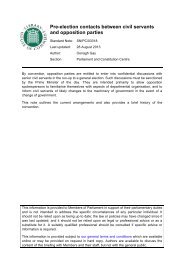- Page 1 and 2: SELECT COMMITTEE ON ECONOMIC AFFAIR
- Page 3 and 4: Professor David Bell—Oral evidenc
- Page 5 and 6: Professor David Bell—Oral evidenc
- Page 7 and 8: Professor David Bell—Oral evidenc
- Page 9 and 10: Professor David Bell—Oral evidenc
- Page 11 and 12: Professor David Bell—Oral evidenc
- Page 13 and 14: Professor David Bell—Oral evidenc
- Page 15 and 16: Professor David Bell—Oral evidenc
- Page 17 and 18: Professor David Bell—Oral evidenc
- Page 19 and 20: Professor David Bell—Oral evidenc
- Page 21: British Academy—Written evidence
- Page 25 and 26: British Academy—Written evidence
- Page 27 and 28: British Academy—Written evidence
- Page 29 and 30: British Academy—Written evidence
- Page 31 and 32: Malcolm Chalmers RUSI—Written evi
- Page 33 and 34: Malcolm Chalmers RUSI—Written evi
- Page 35 and 36: Mr John Cridland, Mr Graeme Leach a
- Page 37 and 38: Mr John Cridland, Mr Graeme Leach a
- Page 39 and 40: Mr John Cridland, Mr Graeme Leach a
- Page 41 and 42: Mr John Cridland, Mr Graeme Leach a
- Page 43 and 44: Mr John Cridland, Mr Graeme Leach a
- Page 45 and 46: Mr John Cridland, Mr Graeme Leach a
- Page 47 and 48: Mr John Cridland, Mr Graeme Leach a
- Page 49 and 50: Mr John Cridland, Mr Graeme Leach a
- Page 51 and 52: Mr John Cridland, Mr Graeme Leach a
- Page 53 and 54: Mr John Cridland, Mr Graeme Leach a
- Page 55 and 56: Dr Karen Henderson—Written eviden
- Page 57 and 58: Dr Karen Henderson—Written eviden
- Page 59 and 60: Dr Karen Henderson—Written eviden
- Page 61 and 62: Dr Karen Henderson—Oral evidence
- Page 63 and 64: Dr Karen Henderson—Oral evidence
- Page 65 and 66: Dr Karen Henderson—Oral evidence
- Page 67 and 68: Dr Karen Henderson—Oral evidence
- Page 69 and 70: Dr Karen Henderson—Oral evidence
- Page 71 and 72: Dr Karen Henderson—Oral evidence
- Page 73 and 74:
Professor Gerald Holtham—Oral evi
- Page 75 and 76:
Professor Gerald Holtham—Oral evi
- Page 77 and 78:
Professor Gerald Holtham—Oral evi
- Page 79 and 80:
Professor Gerald Holtham—Oral evi
- Page 81 and 82:
Professor Gerald Holtham—Oral evi
- Page 83 and 84:
Professor Gerald Holtham—Oral evi
- Page 85 and 86:
Professor Gerald Holtham—Oral evi
- Page 87 and 88:
ICAEW—Written evidence Adopting t
- Page 89 and 90:
ICAEW—Written evidence £13.6 bil
- Page 91 and 92:
ICAEW—Written evidence 27. Conver
- Page 93 and 94:
ICAEW—Written evidence such costs
- Page 95 and 96:
ICAEW—Written evidence stability,
- Page 97 and 98:
ICAEW—Written evidence We would l
- Page 99 and 100:
ICAEW—Written evidence Scotland a
- Page 101 and 102:
ICAEW—Oral evidence (QQ 368-429)
- Page 103 and 104:
ICAEW—Oral evidence (QQ 368-429)
- Page 105 and 106:
ICAEW—Oral evidence (QQ 368-429)
- Page 107 and 108:
ICAEW—Oral evidence (QQ 368-429)
- Page 109 and 110:
ICAEW—Oral evidence (QQ 368-429)
- Page 111 and 112:
ICAEW—Oral evidence (QQ 368-429)
- Page 113 and 114:
ICAEW—Oral evidence (QQ 368-429)
- Page 115 and 116:
ICAEW—Oral evidence (QQ 368-429)
- Page 117 and 118:
ICAEW—Oral evidence (QQ 368-429)
- Page 119 and 120:
ICAS—Written evidence country is
- Page 121 and 122:
ICAS—Written evidence 10) The abo
- Page 123 and 124:
ICAS—Written evidence has been gr
- Page 125 and 126:
ICAS—Written evidence Conclusions
- Page 127 and 128:
ICAS—Written evidence the nature
- Page 129 and 130:
ICAS—Written evidence Scotland fo
- Page 131 and 132:
ICAS—Written evidence Why is the
- Page 133 and 134:
ICAS—Written evidence Question 5
- Page 135 and 136:
ICAS—Written evidence adopt the e
- Page 137 and 138:
Mr Paul Ingram and Professor Iain M
- Page 139 and 140:
Mr Paul Ingram and Professor Iain M
- Page 141 and 142:
Mr Paul Ingram and Professor Iain M
- Page 143 and 144:
Mr Paul Ingram and Professor Iain M
- Page 145 and 146:
Mr Paul Ingram and Professor Iain M
- Page 147 and 148:
Mr Paul Ingram and Professor Iain M
- Page 149 and 150:
Mr Paul Ingram and Professor Iain M
- Page 151 and 152:
Mr Paul Ingram and Professor Iain M
- Page 153 and 154:
Mr Paul Ingram and Professor Iain M
- Page 155 and 156:
Professor John Kay—Oral evidence
- Page 157 and 158:
Professor John Kay—Oral evidence
- Page 159 and 160:
Professor John Kay—Oral evidence
- Page 161 and 162:
Professor John Kay—Oral evidence
- Page 163 and 164:
Professor John Kay—Oral evidence
- Page 165 and 166:
Professor John Kay—Oral evidence
- Page 167 and 168:
Professor John Kay—Oral evidence
- Page 169 and 170:
Professor John Kay—Oral evidence
- Page 171 and 172:
Professor John Kay—Oral evidence
- Page 173 and 174:
Professor John Kay—Oral evidence
- Page 175 and 176:
Professor John Kay—Oral evidence
- Page 177 and 178:
Professor John Kay—Oral evidence
- Page 179 and 180:
Professor Alex Kemp—Written evide
- Page 181 and 182:
Professor Alex Kemp—Written evide
- Page 183 and 184:
Professor Alex Kemp—Written evide
- Page 185 and 186:
Professor Alex Kemp—Written evide
- Page 187 and 188:
Professor Alex Kemp—Written evide
- Page 189 and 190:
Ms Johann Lamont—Written evidence
- Page 191 and 192:
Ms Johann Lamont—Written evidence
- Page 193 and 194:
Ms Johann Lamont—Written evidence
- Page 195 and 196:
Ms Johann Lamont—Written evidence
- Page 197 and 198:
Ms Johann Lamont—Written evidence
- Page 199 and 200:
Ms Johann Lamont—Written evidence
- Page 201 and 202:
Ms Johann Lamont—Written evidence
- Page 203 and 204:
Ms Johann Lamont—Written evidence
- Page 205 and 206:
Mr Graeme Leach, Mr John Cridland,
- Page 207 and 208:
Professor Gavin McCrone—Oral evid
- Page 209 and 210:
Professor Gavin McCrone—Oral evid
- Page 211 and 212:
Professor Gavin McCrone—Oral evid
- Page 213 and 214:
Professor Gavin McCrone—Oral evid
- Page 215 and 216:
Professor Gavin McCrone—Oral evid
- Page 217 and 218:
Professor Gavin McCrone—Oral evid
- Page 219 and 220:
Professor Gavin McCrone—Oral evid
- Page 221 and 222:
Professor Gavin McCrone—Oral evid
- Page 223 and 224:
Professor Gavin McCrone—Oral evid
- Page 225 and 226:
Professor Gavin McCrone—Oral evid
- Page 227 and 228:
Professor Gavin McCrone—Oral evid
- Page 229 and 230:
Professor Gavin McCrone—Oral evid
- Page 231 and 232:
Dr Iain McLean FBA FRSE—Written e
- Page 233 and 234:
Dr Iain McLean FBA FRSE—Written e
- Page 235 and 236:
Dr Iain McLean FBA FRSE—Written e
- Page 237 and 238:
Newcastle International Airport Ltd
- Page 239 and 240:
Professor Robert Rowthorn—Written
- Page 241 and 242:
Professor Robert Rowthorn—Written
- Page 243 and 244:
Professor Robert Rowthorn—Written
- Page 245 and 246:
Professor Robert Rowthorn—Written
- Page 247 and 248:
Professor Robert Rowthorn—Written
- Page 249 and 250:
Professor Robert Rowthorn—Oral ev
- Page 251 and 252:
Professor Robert Rowthorn—Oral ev
- Page 253 and 254:
Professor Robert Rowthorn—Oral ev
- Page 255 and 256:
Professor Robert Rowthorn—Oral ev
- Page 257 and 258:
Professor Robert Rowthorn—Oral ev
- Page 259 and 260:
Professor Robert Rowthorn—Oral ev
- Page 261 and 262:
Professor Robert Rowthorn—Oral ev
- Page 263 and 264:
Professor Robert Rowthorn—Oral ev
- Page 265 and 266:
Professor Robert Rowthorn—Oral ev
- Page 267 and 268:
Ms Katie Schmuecker, Professor John
- Page 269 and 270:
Ms Katie Schmuecker, Professor John
- Page 271 and 272:
Ms Katie Schmuecker, Professor John
- Page 273 and 274:
Ms Katie Schmuecker, Professor John
- Page 275 and 276:
Ms Katie Schmuecker, Professor John
- Page 277 and 278:
Ms Katie Schmuecker, Professor John
- Page 279 and 280:
Ms Katie Schmuecker, Professor John
- Page 281 and 282:
Ms Katie Schmuecker, Professor John
- Page 283 and 284:
Ms Katie Schmuecker, Professor John
- Page 285 and 286:
Ms Katie Schmuecker, Professor John
- Page 287 and 288:
Professor John Simpson, Ms Katie Sc
- Page 289 and 290:
SSE—Written evidence market in Gr
- Page 291 and 292:
Professor John Tomaney, Ms Katie Sc



